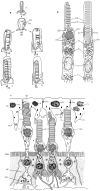Have we achieved a unified model of photoreceptor cell fate specification in vertebrates?
- PMID: 17466954
- PMCID: PMC2288638
- DOI: 10.1016/j.brainres.2007.03.044
Have we achieved a unified model of photoreceptor cell fate specification in vertebrates?
Abstract
How does a retinal progenitor choose to differentiate as a rod or a cone and, if it becomes a cone, which one of their different subtypes? The mechanisms of photoreceptor cell fate specification and differentiation have been extensively investigated in a variety of animal model systems, including human and non-human primates, rodents (mice and rats), chickens, frogs (Xenopus) and fish. It appears timely to discuss whether it is possible to synthesize the resulting information into a unified model applicable to all vertebrates. In this review we focus on several widely used experimental animal model systems to highlight differences in photoreceptor properties among species, the diversity of developmental strategies and solutions that vertebrates use to create retinas with photoreceptors that are adapted to the visual needs of their species, and the limitations of the methods currently available for the investigation of photoreceptor cell fate specification. Based on these considerations, we conclude that we are not yet ready to construct a unified model of photoreceptor cell fate specification in the developing vertebrate retina.
Figures



References
-
- Adler R. A model of retinal cell differentiation in the chick embryo. Prog Retinal Eye Res. 2000;20:529–557. - PubMed
-
- Ahmad I, Acharya HR, Rogers JA, Shibata A, Smithgall TE, Dooley CM. The role of NeuroD as a differentiation factor in the mammalian retina. J Mol Neurosci. 1998;11:165–178. - PubMed
-
- Ahnelt PK, Kolb H. The mammalian photoreceptor mosaic-adaptive design. Prog Retin Eye Res. 2000;19:711–777. - PubMed
-
- Allison WT, Dann SG, Helvik JV, Bradley C, Moyer HD, Hawryshyn CW. Ontogeny of ultraviolet-sensitive cones in the retina of rainbow trout (Oncorhynchus mykiss) J Comp Neurol. 2003;461:294–306. - PubMed
Publication types
MeSH terms
Grants and funding
LinkOut - more resources
Full Text Sources
Medical

